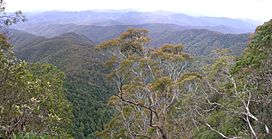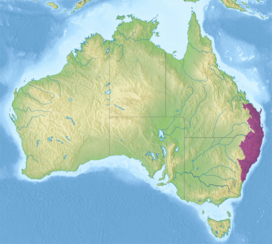Eastern Australian temperate forests facts for kids
Quick facts for kids Eastern Australian temperate forests |
|
|---|---|

|
|

Ecoregion territory (in purple)
|
|
| Ecology | |
| Biome | temperate broadleaf and mixed forests |
| Borders | Brigalow tropical savanna, Southeast Australia temperate forests, and Southeast Australia temperate savanna |
| Bird species | 380 |
| Mammal species | 87 |
| Geography | |
| Area | 222,100 km2 (85,800 sq mi) |
| Country | Australia |
| States | Australian Capital Territory, New South Wales, and Queensland |
| Conservation | |
| Habitat loss | 32.821% |
| Protected | 16.55% |
The Eastern Australian temperate forests are special woodlands in Australia. They stretch along the east coast, from New South Wales up to southern Queensland. These forests are found on higher lands, not right on the flat coast.
This huge area is home to different types of forests. You can find subtropical rainforests, dry rainforests, and even cool temperate rainforests. Each type depends on how much rain it gets and where it is located.
Many National Parks and State Parks protect these amazing forests. However, some areas, especially eucalyptus woodlands, have been cleared. This happened to make space for towns or for animals to graze. Long ago, the Border Ranges National Park had one of Australia's biggest rainforests.
Contents
Where Are These Forests?
This forest region is located between Australia's east coast and the Great Dividing Range. It starts just north of Eden, New South Wales. It includes parts of the famous Blue Mountains near Sydney. The forests then continue north, ending in southern Queensland's Border Ranges National Park.
Some parts of Sydney, like The Hills Shire and Sutherland Shire, have wet and lush areas that are part of these forests. But other parts of Sydney are drier.
Along the coast in southern Queensland and northern New South Wales, you'll find wet eucalyptus forests. Their tree canopies cover 30% to 70% of the sky. The ground below is filled with small trees, vines, ferns, and shrubs.
Subtropical rainforests grow in warm, fertile places. They need more than 1,300 mm of rain each year. Dry rainforests get less rain, between 600 mm and 1,100 mm annually. Sadly, much of the dry rainforest in southeastern Queensland has been cleared for farms.
Warm temperate rainforests are less diverse. They grow in soils that don't have many nutrients. You can find them mostly in the southern part of the ecoregion, around Sydney. The Blue Mountains area is special, with over 90 types of eucalyptus trees! That's about 13% of all eucalyptus types in the world.
What's the Weather Like?
The climate in these forests changes from south to north. In the south, it's an oceanic climate, which means it's mild and wet. As you go north, it becomes a Humid subtropical climate, which is warmer and still humid.
In the central Blue Mountains, it rains a lot, about 1,100 to 1,400 mm every year. Coastal areas are very humid, with even more rain, from 1,200 to 1,600 mm annually. As you move inland to the New England region, like in Armidale, the rainfall drops to about 800 mm per year. Winters there can be cold and wet, and higher areas often get snow.
Further north in the Border Ranges, summer temperatures are around 20-21 degrees Celsius. Winter temperatures are milder, around 12-17 degrees Celsius. Most of the rain in this ecoregion falls during the summer.
Amazing Plants of the Forests
The main trees here are peppermint eucalyptus trees. People used to think the moisture from these trees caused the blue mist that gave the Blue Mountains their name! Along the coast, you'll find shrubs and heaths growing in sandy soil. These include plants from families like Ericaceae, Myrtaceae, and Proteaceae. The Border Ranges alone are home to over 1,200 types of vascular plants.
Many kinds of eucalyptus trees grow in this large region:
- In southern Queensland and northern New South Wales, you'll see tallowwood (Eucalyptus microcorys), blackbutt (Eucalyptus pilularis), and flooded gum (Eucalyptus grandis).
- In southern New South Wales, Sydney blue gum (Eucalyptus saligna) and grey ironbark (Eucalyptus paniculata) are common.
- On the New South Wales coast, a type of stringybark (Eucalyptus eugenioides) grows.
In the warm temperate forests, you might find coachwood (Ceratopetalum apetalum), sassafras (Doryphora sassafras), and lillypilly (Acmena smithii). Cooler temperate forests have trees like Eucryphia moorei and Antarctic beech (Nothofagus moorei).
Some areas are especially rich in unique plants found nowhere else. These include the eucalyptus in the Blue Mountains and the rainforests of the Border Ranges area. This area includes places like Mount Warning and Lamington National Park. The sand dunes of Fraser Island are also a special place for plants. Many rainforests here are protected as the Gondwana Rainforests of Australia.
Animals of the Forests
These forests are full of amazing wildlife! You might find velvet worms and koalas. Birds include kookaburra kingfishers, gang-gang cockatoos, and crimson rosellas.
Some rare and threatened birds also live here:
- Red goshawk (Erythrotriorchis radiatus)
- Swift parrot (Lathamus discolor)
- Regent honeyeater (Xanthomyza phrygia)
- Albert's lyrebird (Menura alberti)
- Eastern bristlebird (Dasyornis brachypterus)
The Blue Mountains alone are home to over 60 types of reptiles, 65 types of mammals, and 275 types of birds. You can also find the broad-headed snake and the stuttering frog in this region.
Protecting These Forests
These beautiful habitats face some challenges. They are at risk from being cleared for farms and towns. Fires can also be a big problem. Introduced species (plants and animals brought from other places) and water pollution also threaten the native wildlife.
However, many areas are protected. Logging of some trees like tallowwood and Sydney blue gum is done in a controlled way. This helps keep large areas of these native trees healthy. Many national parks, like Royal National Park near Sydney, also protect these diverse habitats. Large cities like Sydney and Brisbane are in this ecoregion, as are popular tourist spots like North Stradbroke Island.
National Parks in the Ecoregion

Here is a list of some of the national parks found in this ecoregion, from north to south:
- Border Ranges National Park
- Washpool National Park
- Willi Willi National Park
- Werrikimbe National Park
- Cottan-Bimbang National Park
- Barrington Tops National Park
- Myall Lakes National Park
- Brisbane Water National Park
- Berowra Valley National Park
- Ku-ring-gai Chase National Park
- Dharug National Park
- Blue Mountains National Park
- Royal National Park
- Marramarra National Park
- Dharawal National Park
- Budderoo National Park
- Budawang National Park
- Monga National Park
- Deua National Park
- Wadbilliga National Park
- Mimosa Rocks National Park
- Wadbilliga National Park
See also
 In Spanish: Bosques templados de Australia oriental para niños
In Spanish: Bosques templados de Australia oriental para niños



